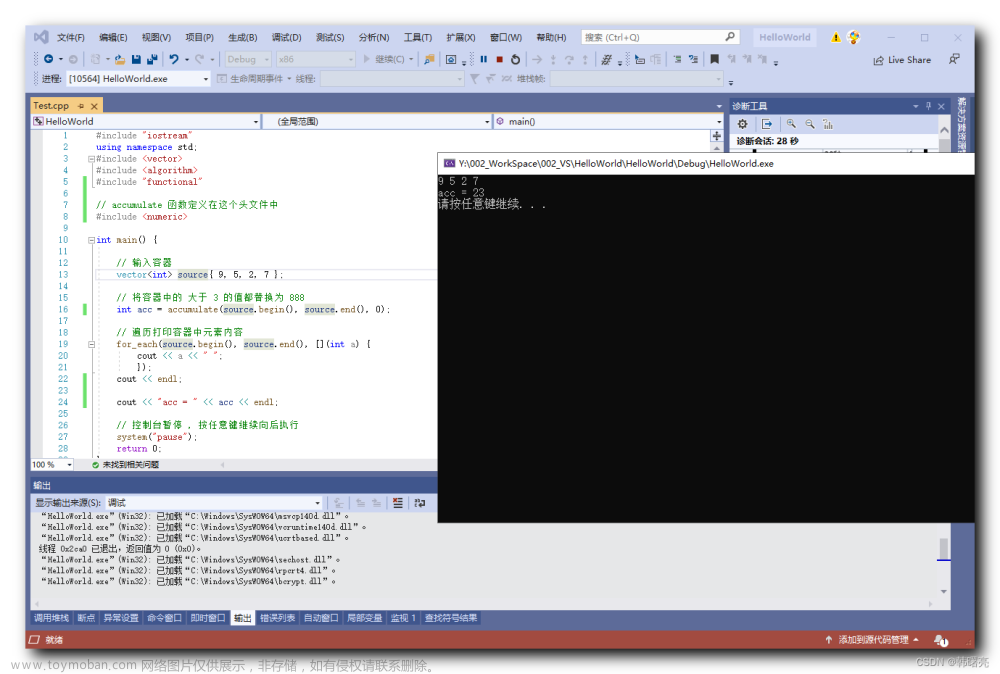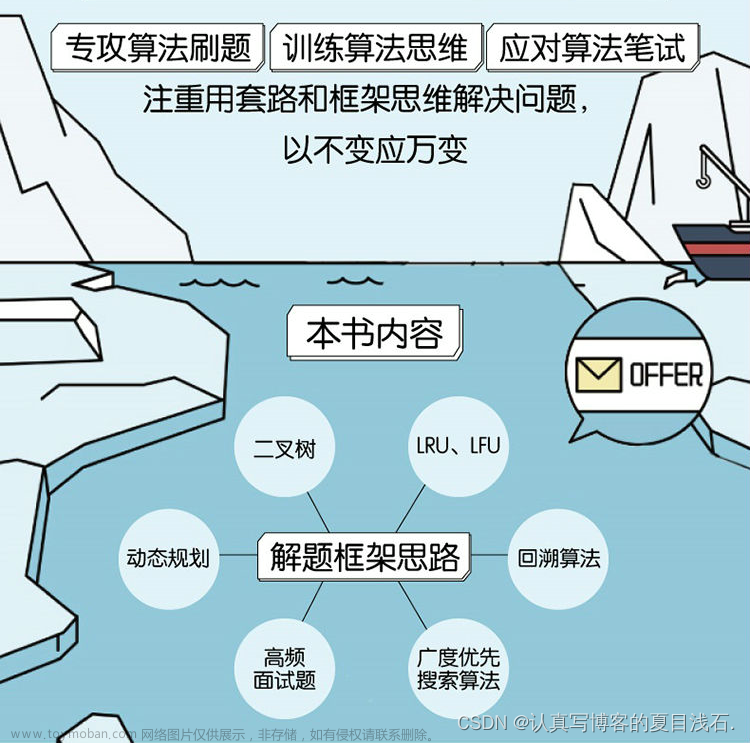算法别名:
漫水填充算法、种子填充算法(Seed Fill)
作用:
用于确定连接到多维数组中给定节点的区域,可以用来标记或者分离图像的一部分,实现如Ps中自动选区功能。
基本思想:
顾名思义就像洪水漫过一样,把一块连通的区域填满。
当然水要能漫过需要满足一定的条件,可以理解为满足条件的地方就是低洼的地方,水才能流过去。
在图像处理中就是给定一个种子点作为起始点,向附近相邻的像素点扩散,把颜色相同或者相近的所有点都找出来,并填充上新的颜色,这些点形成一个连通的区域。
算法参数:
- 起始节点(start node)
- 目标颜色(target color)
- 替换颜色(replacement color)
算法实现:
漫水填充算法实现最常见有四邻域像素填充法,八邻域像素填充法,基于扫描线的填充方法。根据代码实现方式又可以分为递归与非递归。
1、四邻域递归实现

将像素点(x,y)周围的上下左右四个点分别进行着色。
//Recursive 4-way floodfill, crashes if recursion stack is full
public void floodFill4(int x, int y, int newColor, int oldColor)
{
if(x >= 0 && x < width && y >= 0 && y < height
&& getPixel(x, y) == oldColor && getPixel(x, y) != newColor)
{
setPixel(x, y, newColor); //set color before starting recursion
floodFill4(x + 1, y, newColor, oldColor);
floodFill4(x - 1, y, newColor, oldColor);
floodFill4(x, y + 1, newColor, oldColor);
floodFill4(x, y - 1, newColor, oldColor);
}
}2、八邻域递归实现

将一个像素点的上下左右,左上,左下,右上,右下都进行着色。
public void floodFill8(int x, int y, int newColor, int oldColor)
{
if(x >= 0 && x < width && y >= 0 && y < height &&
getPixel(x, y) == oldColor && getPixel(x, y) != newColor)
{
setPixel(x, y, newColor); //set color before starting recursion
floodFill8(x + 1, y, newColor, oldColor);
floodFill8(x - 1, y, newColor, oldColor);
floodFill8(x, y + 1, newColor, oldColor);
floodFill8(x, y - 1, newColor, oldColor);
floodFill8(x + 1, y + 1, newColor, oldColor);
floodFill8(x - 1, y - 1, newColor, oldColor);
floodFill8(x - 1, y + 1, newColor, oldColor);
floodFill8(x + 1, y - 1, newColor, oldColor);
}
} 3、扫描线算法(Scanline Fill):

利用填充线来加速算法, 它不是在堆栈上推动每个潜在的未来像素坐标,而是检查相邻线(前一个和下一个)以找到可能在未来通过中填充的相邻段, 线段的坐标(开始或结束)被推到堆栈上。 在大多数情况下,该扫描线算法至少比每像素算法快一个数量级。
该算法的过程是:先扫描一行或者一列内的连通像素,然后再上下行或者左右列扫描,可以减少递归栈的深度。
递归方式:
递归实现算法好理解,但当连通的区域很大时,很可能会导致栈溢出。
void floodFillScanline(int x, int y, int newColor, int oldColor){
if(newColor==oldColor) return;
if(screen[x][y]!=oldColor) return;
int x1=x;
while(x1<w&&screen[x1][y]==oldColor){
screen[x1][y]=newColor;
x1++;
}
x1=x-1;
while(x1>=0&&screen[x1][y]==oldColor){
screen[x1][y]=newColor;
x1--;
}
x1=x;
while(x1<w&&screen[x1][y]==newColor){
if(y<h-1&&screen[x1][y+1]==oldColor) floodFillScanline(x1,y+1,newColor,oldColor);
x1++;
}
x1=x-1;
while(x1>0&&screen[x1][y]==newColor){
if(y>0&&screen[x1][y+1]==oldColor) floodFillScanline(x1,y+1,newColor,oldColor);
x1--;
}
x1=x;
while(x1<w&&screen[x1][y]==newColor){
if(y<h-1&&screen[x1][y-1]==oldColor) floodFillScanline(x1,y+1,newColor,oldColor);
x1++;
}
x1=x-1;
while(x1>0&&screen[x1][y]==newColor){
if(y>0&&screen[x1][y-1]==oldColor) floodFillScanline(x1,y+1,newColor,oldColor);
x1--;
}
}
非递归方式:
void floodFillScanline(int x, int y, int newColor, int oldColor){
if(newColor==oldColor) return;
if(screen[x][y]!=oldColor) return;
emptyStack();
int x1;
bool spanAbove, spanBelow;
if(!push(x,y)) return;
while(pop(x,y)){
x1=x;
while(x1>0&&screen[x1][y]==oldColor) x1--;
x1++;
spanAbove = spanBelow = 0;
while(x1<w&&screen[x1][y]==oldColor){
screen[x1][y]=newColor;
if(!spanAbove&&y>0&&screen[x1][y-1]==oldColor){ //这里判断出了上行的元素可以被染色,可能为了修改screen的访存连续性,所以这里没修改。而且你改了上行的值,却没考虑其四周,会有完备性的问题。
if(!push(x1,y-1)) return;
spanAbove=1;
}
else if(spanAbove&&y>0&&screen[x1][y-1]!=oldColor){
spanAbove=0; //不压入重复过多的元素
}
if(!spanBelow&&y<h-1&&screen[x1][y+1]==oldColor){
if(!push(x1,y+1)) return;
spanBelow=1;
}
else if(spanBelow&&y<h-1&&screen[x1][y+1]!=oldColor){
spanBelow=0;
}
x1++;
}
}
}4、OpenCV 的 floodFill 函数
在OpenCV中,漫水填充算法由floodFill函数实现,可以从指定的种子点开始填充一个连通域。连通性由像素值的接近程度来衡量。
OpenCV2.X 有两个C++重载的floodFill函数:
/* fills the semi-uniform image region starting from the specified seed point*/
CV_EXPORTS int floodFill( InputOutputArray image,
Point seedPoint,
Scalar newVal,
CV_OUT Rect* rect=0,
Scalar loDiff=Scalar(),
Scalar upDiff=Scalar(),
int flags=4 );
/* fills the semi-uniform image region and/or the mask starting from the
specified seed point*/
CV_EXPORTS int floodFill( InputOutputArray image,
InputOutputArray mask,
Point seedPoint,
Scalar newVal,
CV_OUT Rect* rect=0,
Scalar loDiff=Scalar(),
Scalar upDiff=Scalar(),
int flags=4 );• image 要处理的图片,既是入参也是出参,接受单通道或3通道,8位或浮点类型的图片。如果提供了Mask而且设置了 FLOODFILL_MASK_ONLY 的flag,输入图像才不会被修改,否则调用本方法填充的结果会修改到输入图像中。
• mask 掩码图像,既是入参也是出参,接受单通道8位的图片,要求比要处理的图片宽和高各大两个像素。mask要先初始化好,填充算法不能漫过mask中非0的区域。比如可以用边缘检测的结果来做为mask,以防止边缘被填充。做为输出参数,mask对应图片中被填充的像素会被置为1或者下面参数指定的值。因此当多次调用floodFill方法,使用同一个mask时,可以避免填充区域叠加和重复计算。 因为 mask比image大,所以image中的点 p(x,y),对应mask中的点 p(x+1, y+1)
• seedPoint 填充算法的种子点,即起始点
• newVal 填充的颜色
• loDiff 最小的亮度或颜色的差值
• upDiff 最大的亮度者颜色的差值
• rect 可选的输出参数,返回一个最小的矩形,可以刚好把填充的连通域包起来。
• flags
- 低八位[0-7]表示连通性,默认值4表示四领域填充,8表示八领域填充。
- [8-15]位表示用来填充mask的颜色值[1-255]默认是1
- 比如flag值(4|(255«8)) 表示使用四领域填充,mask填充色值是255。
- 剩余的位有两个值可以单独设置或者用(|)同时设置:
FLOODFILL_MASK_ONLY 表示不修改原始输入图像,只把结果输出到mask图中,在mask中将填充区域标上前面flag中指定的值。newVal的参数值将被忽略。
FLOODFILL_FIXED_RANGE 表示待填充像素只和种子点比较。如果不设置这个标记,表示待填充的像素是和相邻的像素比较(相当于差值范围是浮动的),这种情况下填充区域的像素可能会和种子点相差越来越大。文章来源:https://www.toymoban.com/news/detail-624981.html
参考链接
以下为本博客的参考内容:文章来源地址https://www.toymoban.com/news/detail-624981.html
- 图像处理之漫水填充算法(flood fill algorithm) - 腾讯云开发者社区-腾讯云 (tencent.com)
- Flood fill Algorithm // 谭邵杰的计算机奇妙旅程 (ustc.edu.cn)
- 图像分割经典算法--《泛洪算法》(Flood Fill)_我的她像朵花的博客-CSDN博客_泛洪算法
到了这里,关于算法介绍 | 泛洪算法(Flood fill Algorithm)的文章就介绍完了。如果您还想了解更多内容,请在右上角搜索TOY模板网以前的文章或继续浏览下面的相关文章,希望大家以后多多支持TOY模板网!












